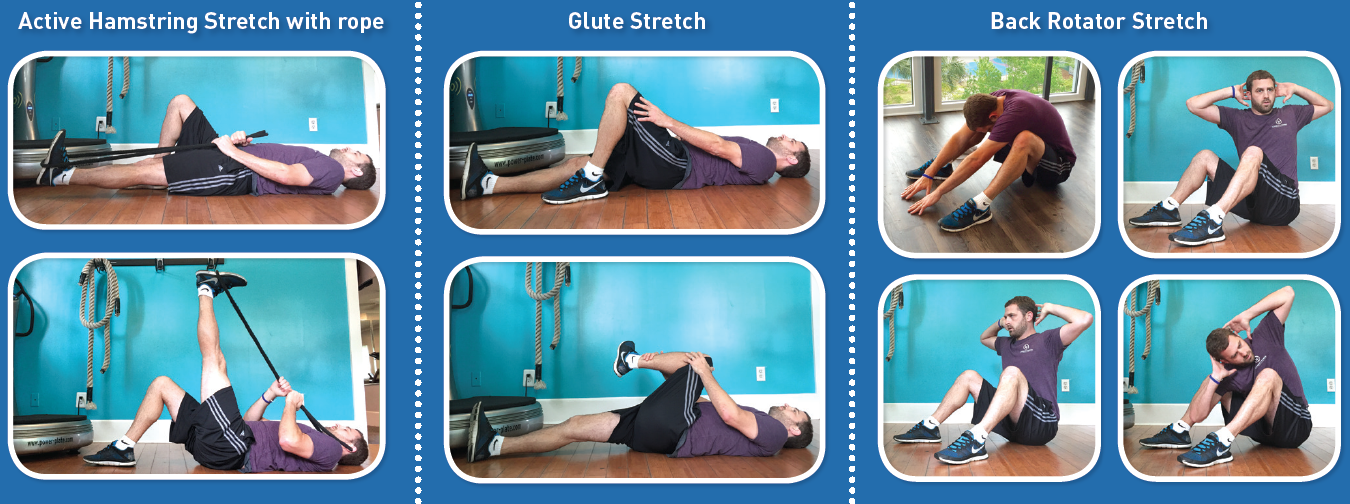by Jeremy Mayer, US Squash National Team Sports Physiologist
Stretching is a term that most people associate with gym class or playing sports as a kid. As a group you would hold, count to ten and then move on to the next tortuously boring and sometimes downright painful position. The butterfly, reaching for the toes and jackknife were all standards taught to us by professionals who preached the benefits of these old school “hold ‘til it hurts” stretches.
Once out of grade school most of us then resorted to following some variation of this same stretching routine until we realized that (1) It’s not as effective as advertised, or (2) There is limited time in our day and stretching is the first aspect of health and fitness left by the wayside. Then a funny thing happens as we age – we start getting weaker and less flexible. We develop aches and pains from sitting all day at work, traveling, doing household chores, or poor sleep (waking up feeling worse than when we went to bed!).
It doesn’t have to be this way. We are built to move and bend and reach and squat without pain at any age. So where did it all go wrong?
The first has to do with the way loading patterns of our musculoskeletal system change as we age. This simply means that we stop using our body in dynamic ways (like kids do) and in turn fall into daily patterns and routines that we repeat constantly. This in and by itself doesn’t cause pain and “tightness”, but it does lead to weakening of the muscles. This weakening then doesn’t allow you to move the way you used to when playing squash, going for a run or taking a fitness class for that matter.
Think of it this way, you are essentially training your body all day long to sit, stand, walk then sit some more. Don’t be surprised if it responds negatively when you then ask it on the weekend or in a lunchtime squash match to run, bend, reach and lunge.
So back to the question at hand: “why stretch for squash?” It’s a simple answer. You should stretch to:
• Increase the range of motion (ROM) of your joints
• Develop muscular strength through more dynamic ROM
• Stimulate greater communication between your central nervous system and muscles.
In order to find the best methods to achieve the above, you should first understand that your body is always under some degree of tension even at complete rest. As you become more “tight” (or more accurately “weaker with a decreased ROM”) that tension intensifies. This is again caused by fewer dynamic movement patterns in your daily life. As muscles weaken, the nervous system begins to limit your ROM.
This feels like “tightness” but is really your nervous system’s way to prevent you from moving your joints in ways that could cause injury.
There is a misconception—not supported by existing scientific research—that stretching mechanically lengthens the muscle. Think of muscles like a rubber band—they can be stretched, but once the load is removed it returns to its original shape. Stretching more and harder passively in order to achieve lengthening actually weakens the muscle, provides little to no neuromuscular adaptation and causes damage to the connective tissue.
An increase in flexibility comes from nervous system and strength adaptation allowing for increased joint ROM, not by lengthening the muscle itself. On the other hand, active or dynamic stretching stimulates “brain to muscle contact.” This form of stretching promotes strength development through increased ranges of motion and increased tolerance by the nervous system leading to greater flexibility. This leads to better movement with lower risk of injury on the court.
In order to use the concepts of active or dynamic stretching as opposed to statically holding a stretch, some tips are to:
• Move more frequently in a variety of dynamic movement patterns
• Increase load or resistance gradually through these full ranges of motion
• Stop the “push harder” mentality when stretching.
Here are a few examples of Active Isolated Stretches for Squash:



